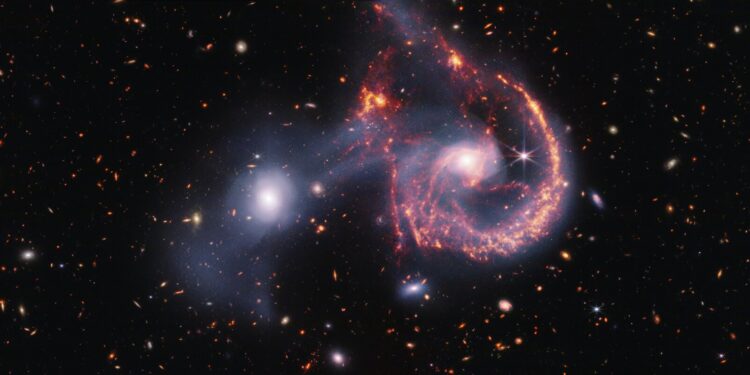This composite image of Arp 107, created using data from the James Webb Space Telescope’s Near-Infrared Camera (NIRCam) and Mid-Infrared Instrument (MIRI), reveals a wealth of information about star formation and how these two galaxies collided hundreds of millions of years ago. The near-infrared data, shown in white, shows the older stars, which shine brightly in both galaxies, as well as the tenuous bridge of gas and stars that connects them. The vibrant background galaxies are also brightly illuminated in this wavelength. On the other hand, the MIRI data shows the young stars and star-forming regions in bright orange and red. Our mid-infrared view offers the best view of the collision point, given the gap visible at the top of the spiral galaxy. This collision not only triggered a new wave of star formation in the region, but also an endearing smile. Credit: NASA, ESA, CSA, STScI
An interaction between an elliptical galaxy and a spiral galaxy, collectively known as Arp 107, appears to have given the spiral a happier appearance, with its two bright “eyes” and wide, semicircular “smile.” The region was first observed in infrared by NASA’s Spitzer Space Telescope in 2005. However, NASA’s James Webb Space Telescope is displaying it at much higher resolution. This image is a composite, combining observations from Webb’s Mid-Infrared Instrument (MIRI) and Near-Infrared Camera (NIRCam).
The NIRCam camera highlights the stars in both galaxies and reveals the connection between them: a white, transparent bridge of stars and gas extracted from the two galaxies as they pass by. The MIRI data, shown in red-orange, show star-forming regions and dust composed of soot-like organic molecules called polycyclic aromatic hydrocarbons. MIRI also provides a snapshot of the bright core of the large spiral, which is home to a supermassive black hole.
The spiral galaxy is classified as a Seyfert galaxy, one of the two largest groups of active galaxies, along with galaxies that host quasars. Seyfert galaxies are not as bright and distant as quasars, making them a more practical way to study similar phenomena in lower-energy light, such as infrared.
This pair of galaxies is similar to the Cartilaginous Galaxy, one of the first interacting galaxies observed by Webb. Arp 107 could have looked a lot like the Cartilaginous Galaxy, but because the smaller elliptical galaxy likely had an off-center collision rather than a direct impact, the spiral galaxy escaped with only its spiral arms disrupted.
-
This image of Arp 107, obtained by Webb’s Mid-InfraRed Instrument (MIRI), reveals the supermassive black hole at the center of the large spiral galaxy on the right, as evidenced by the small, bright central “core.” This bright core, where the black hole is drawing much of the dust into lanes, also exhibits Webb’s characteristic diffraction peaks, caused by the light it emits interacting with the structure of the telescope itself. Perhaps the defining feature of the region, revealed by MIRI, is the millions of young stars forming, highlighted in blue. These stars are surrounded by dusty silicates and soot-like molecules known as polycyclic aromatic hydrocarbons. The small elliptical galaxy on the left, which has already completed much of its star formation, is composed of many of these organic molecules. Credit: NASA, ESA, CSA, STScI
-
The north and east arrows on the compass indicate the orientation of the image in the sky. Note that the relationship between north and east in the sky (as seen from below) is reversed compared to the direction arrows on a map of the ground (as seen from above). The scale bar is labeled in light-years, which is the distance that light travels in one Earth year. (It takes 75,000 years for light to travel a distance equal to the length of the bar.) One light-year is approximately 5.88 trillion miles or 9.46 trillion kilometers. The field of view shown in this image is approximately 450,000 light-years. This image shows invisible near-infrared and mid-infrared wavelengths that have been translated into visible light colors. The color legend indicates which NIRCam and MIRI filters were used when collecting the light. The color of each filter name is the color of visible light used to represent the infrared light passing through that filter. Credits: NASA, ESA, CSA, STScI
The collision isn’t as bad as it sounds. While star formation has happened before, collisions between galaxies can compress gas, improving the conditions for new stars to form. On the other hand, as Webb reveals, collisions also scatter a lot of gas, potentially depriving new stars of the material they need to form.
Webb captured these galaxies in the process of merging, which will take hundreds of millions of years. As the two galaxies rebuild after the chaos of their collision, Arp 107 may lose its smile, but it will inevitably transform into something just as interesting for future astronomers to study.
Arp 107 is located 465 million light-years from Earth in the constellation Leo Minor.
Quote:Webb Telescope Offers Another Glimpse of Galactic Collisions (2024, September 18) retrieved September 18, 2024 from
This document is subject to copyright. Apart from any fair dealing for the purpose of private study or research, no part may be reproduced without written permission. The content is provided for informational purposes only.



